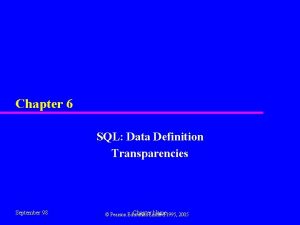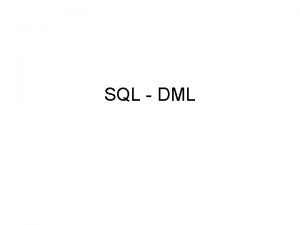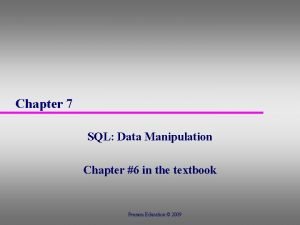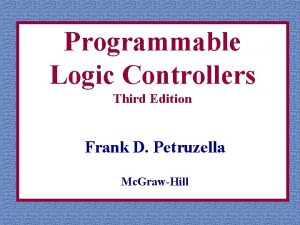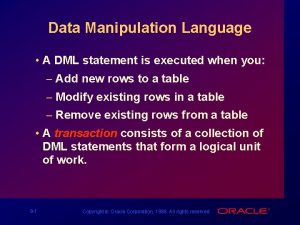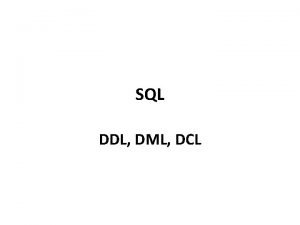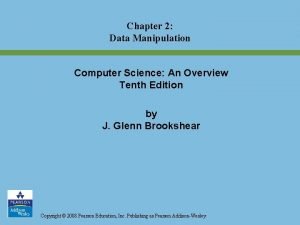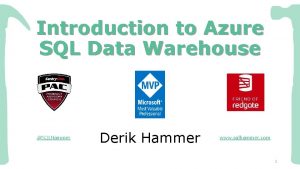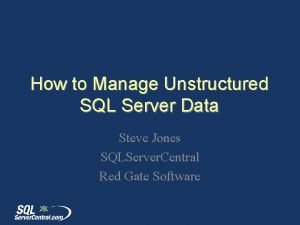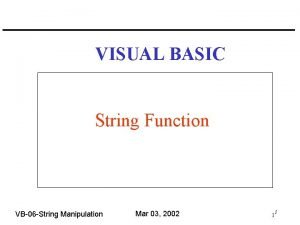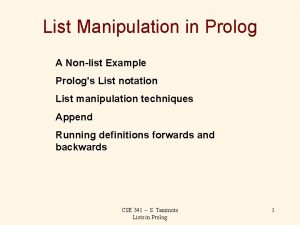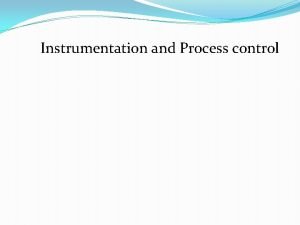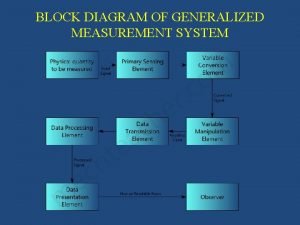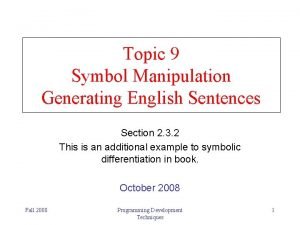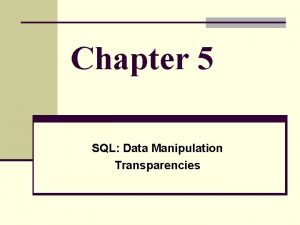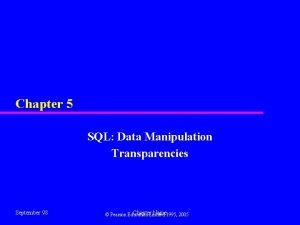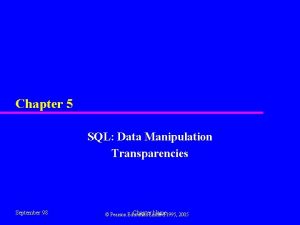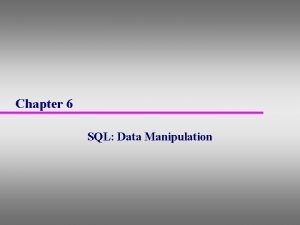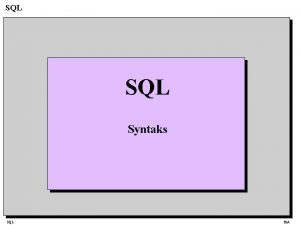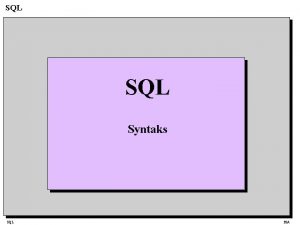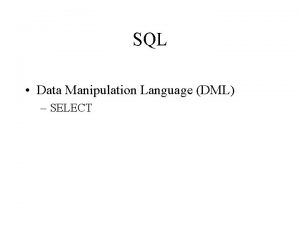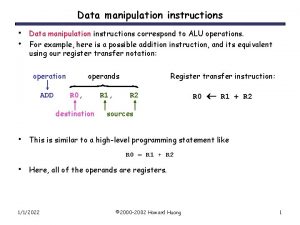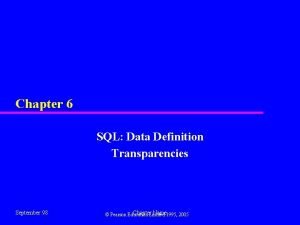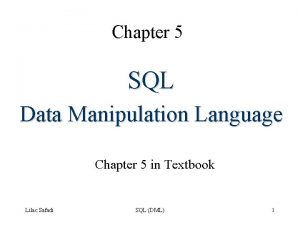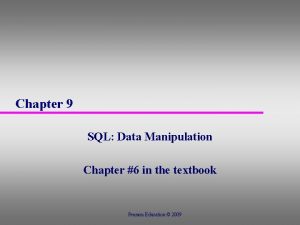Chapter 11 SQL Data Manipulation Transparencies From the


![SELECT Statement SELECT [DISTINCT | ALL] {* | [column. Expression [AS new. Name]] [, SELECT Statement SELECT [DISTINCT | ALL] {* | [column. Expression [AS new. Name]] [,](https://slidetodoc.com/presentation_image_h/74ff1340528b88c071973abd1bfe5dec/image-3.jpg)

































































































![INSERT INTO Table. Name [ (column. List) ] VALUES (data. Value. List) n column. INSERT INTO Table. Name [ (column. List) ] VALUES (data. Value. List) n column.](https://slidetodoc.com/presentation_image_h/74ff1340528b88c071973abd1bfe5dec/image-101.jpg)











![DELETE FROM Table. Name [WHERE search. Condition] n Table. Name can be name of DELETE FROM Table. Name [WHERE search. Condition] n Table. Name can be name of](https://slidetodoc.com/presentation_image_h/74ff1340528b88c071973abd1bfe5dec/image-113.jpg)

- Slides: 114

Chapter 11 SQL: Data Manipulation Transparencies (From the textbook By Thomas Connolly (Chapter 5)) 1

Chapter 11 - Objectives n Purpose and importance of SQL. n How to retrieve data from database using SELECT and: Use compound WHERE conditions. n Sort query results using ORDER BY. n Use aggregate functions. n Group data using GROUP BY and HAVING. n Use subqueries. n 2
![SELECT Statement SELECT DISTINCT ALL column Expression AS new Name SELECT Statement SELECT [DISTINCT | ALL] {* | [column. Expression [AS new. Name]] [,](https://slidetodoc.com/presentation_image_h/74ff1340528b88c071973abd1bfe5dec/image-3.jpg)
SELECT Statement SELECT [DISTINCT | ALL] {* | [column. Expression [AS new. Name]] [, . . . ] } FROM Table. Name [alias] [, . . . ] [WHERE condition] [GROUP BY column. List] [HAVING condition] [ORDER BY column. List] 3

SELECT Statement FROM Specifies table(s) to be used. WHERE Filters rows. GROUP with rows BY of groups Forms same column value. HAVING Filters groups subject to some condition. SELECT to Specifies which columns are appear in output. ORDER BY output. Specifies the order of the 4

SELECT Statement n Order of the clauses cannot be changed. n Only SELECT and FROM are mandatory. 5

Example 5. 1 Rows All Columns, All List full details of all staff. SELECT staff. No, f. Name, l. Name, address, position, sex, DOB, salary, branch. No FROM Staff; n Can use * as an abbreviation for ‘all columns’: SELECT * FROM Staff; 6

Example 5. 1 Rows All Columns, All 7

Example 5. 2 Specific Columns, All Rows Produce a list of salaries for all staff, showing only staff number, first and last names, and salary. SELECT staff. No, f. Name, l. Name, salary FROM Staff; 8

Example 5. 2 Specific Columns, All Rows 9

Example 5. 3 Use of DISTINCT List the property numbers of all properties that have been viewed. SELECT property. No FROM Viewing; 10

Example 5. 3 Use of DISTINCT n Use DISTINCT to eliminate duplicates: SELECT DISTINCT property. No FROM Viewing; 11

Example 5. 4 Calculated Fields Produce a list of monthly salaries for all staff, showing staff number, first and last names, and salary details. SELECT staff. No, f. Name, l. Name, salary/12 FROM Staff; 12

Example 5. 4 Calculated Fields n To name column, use AS clause: SELECT staff. No, f. Name, l. Name, salary/12 AS monthly. Salary FROM Staff; 13

Example 5. 5 Comparison Search Condition List all staff with a salary greater than 10, 000. SELECT staff. No, f. Name, l. Name, position, salary FROM Staff WHERE salary > 10000; 14

Example 5. 6 Compound Comparison Search Condition List addresses of all branch offices in London or Glasgow. SELECT * FROM Branch WHERE city = ‘London’ OR city = ‘Glasgow’; 15

Example 5. 7 Condition Range Search List all staff with a salary between 20, 000 and 30, 000. SELECT staff. No, f. Name, l. Name, position, salary FROM Staff WHERE salary BETWEEN 20000 AND 30000; n BETWEEN test includes the endpoints of range. 16

Example 5. 7 Condition Range Search 17

Example 5. 7 Condition Range Search n Also a negated version NOT BETWEEN. n BETWEEN does not add much to SQL’s expressive power. Could also write: SELECT staff. No, f. Name, l. Name, position, salary FROM Staff WHERE salary>=20000 AND salary <= 30000; n Useful, though, for a range of values. 18

Example 5. 8 Set Membership List all managers and supervisors. SELECT staff. No, f. Name, l. Name, position FROM Staff WHERE position IN (‘Manager’, ‘Supervisor’); 19

Example 5. 8 Set Membership There is a negated version (NOT IN). n IN does not add much to SQL’s expressive power. n Could have expressed this as: n SELECT staff. No, f. Name, l. Name, position FROM Staff WHERE position=‘Manager’ OR position=‘Supervisor’; IN is more efficient when set contains many values. n 20

Example 5. 9 Pattern Matching Find all owners with the string ‘Glasgow’ in their address. SELECT client. No, f. Name, l. Name, address, tel. No FROM Private. Owner WHERE address LIKE ‘%Glasgow%’; 21

Example 5. 9 Pattern Matching n SQL has two special pattern matching symbols: %: sequence of zero or more characters; n _ (underscore): any single character. n n LIKE ‘%Glasgow%’ means a sequence of characters ‘Glasgow’. of any length containing 22

Example 5. 10 Condition NULL Search List details of all viewings on property PG 4 where a comment has not been supplied. n There are 2 viewings for property PG 4, one with and one without a comment. n Have to test for null explicitly using special keyword IS NULL: SELECT client. No, view. Date FROM Viewing WHERE property. No = ‘PG 4’ AND comment IS NULL; 23

Example 5. 10 Condition NULL Search n Negated version (IS NOT NULL) can test for non-null values. 24

Example 5. 11 Ordering Single Column List salaries for all staff, arranged in descending order of salary. SELECT staff. No, f. Name, l. Name, salary FROM Staff ORDER BY salary DESC; 25

Example 5. 11 Ordering Single Column 26

Example 5. 12 Ordering Multiple Column Produce abbreviated list of properties in order of property type. SELECT property. No, type, rooms, rent FROM Property. For. Rent ORDER BY type; 27

Example 5. 12 Multiple Column Ordering 28

Example 5. 12 Multiple Column Ordering n Four flats in this list - as no minor sort key specified, system arranges these rows in any order it chooses. n To arrange in order of rent, specify minor order: SELECT property. No, type, rooms, rent FROM Property. For. Rent ORDER BY type, rent DESC; 29

Example 5. 12 Ordering Multiple Column 30

SELECT Statement - Aggregates n ISO standard defines five aggregate functions: COUNT returns number of values in specified column. SUM returns sum of values in specified column. AVG returns average of values in specified column. MIN returns smallest value in specified column. MAX returns largest value in specified column. 31

SELECT Statement - Aggregates n Each operates on a single column of a table and returns a single value. n COUNT, MIN, and MAX apply to numeric and non-numeric fields, but SUM and AVG may be used on numeric fields only. n Apart from COUNT(*), each function eliminates nulls first and operates only on remaining non-null values. 32

SELECT Statement - Aggregates n COUNT(*) counts all rows of a table, regardless of whether nulls or duplicate values occur. n Can use DISTINCT before column name to eliminate duplicates. n DISTINCT has no effect with MIN/MAX, but may have with SUM/AVG. 33

SELECT Statement - Aggregates n Aggregate functions can be used only in SELECT list and in HAVING clause. n If SELECT list includes an aggregate function and there is no GROUP BY clause, SELECT list cannot reference a column out with an aggregate function. For example, the following is illegal: SELECT staff. No, COUNT(salary) FROM Staff; 34

Example 5. 13 Use of COUNT(*) How many properties cost more than £ 350 per month to rent? SELECT COUNT(*) AS count FROM Property. For. Rent WHERE rent > 350; 35

Example 5. 14 COUNT(DISTINCT) Use of How many different properties viewed in May ‘ 01? SELECT COUNT(DISTINCT property. No) AS count FROM Viewing WHERE view. Date BETWEEN ‘ 1 -May-01’ AND ‘ 31 -May-01’; 36

Example 5. 15 Use of COUNT and SUM Find number of Managers and sum of their salaries. SELECT COUNT(staff. No) AS count, SUM(salary) AS sum FROM Staff WHERE position = ‘Manager’; 37

Example 5. 16 Use of MIN, MAX, AVG Find minimum, maximum, and average staff salary. SELECT MIN(salary) AS min, MAX(salary) AS max, AVG(salary) AS avg FROM Staff; 38

SELECT Statement - Grouping n Use GROUP BY clause to get sub-totals. n SELECT and GROUP BY closely integrated: each item in SELECT list must be singlevalued per group, and SELECT clause may only contain: column names n aggregate functions n constants n expression involving combinations of the above. n 39

SELECT Statement - Grouping n All column names in SELECT list must appear in GROUP BY clause unless name is used only in an aggregate function. n If WHERE is used with GROUP BY, WHERE is applied first, then groups are formed from remaining rows satisfying predicate. n ISO considers two nulls to be equal for purposes of GROUP BY. 40

Example 5. 17 Use of GROUP BY Find number of staff in each branch and their total salaries. SELECT branch. No, COUNT(staff. No) AS count, SUM(salary) AS sum FROM Staff GROUP BY branch. No ORDER BY branch. No; 41

Example 5. 17 Use of GROUP BY 42

Restricted Groupings – HAVING clause n HAVING clause is designed for use with GROUP BY to restrict groups that appear in final result table. n Similar to WHERE, but WHERE filters individual rows whereas HAVING filters groups. n Column names in HAVING clause must also appear in the GROUP BY list or be contained within an aggregate function. 43

Example 5. 18 Use of HAVING For each branch with more than 1 member of staff, find number of staff in each branch and sum of their salaries. SELECT branch. No, COUNT(staff. No) AS count, SUM(salary) AS sum FROM Staff GROUP BY branch. No HAVING COUNT(staff. No) > 1 ORDER BY branch. No; 44

Example 5. 18 Use of HAVING 45

Subqueries n Some SQL statements can have a SELECT embedded within them. n A subselect can be used in WHERE and HAVING clauses of an outer SELECT, where it is called a subquery or nested query. n Subselects may also appear in INSERT, UPDATE, and DELETE statements. 46

Example 5. 19 Subquery with Equality List staff who work in branch at ‘ 163 Main St’. SELECT staff. No, f. Name, l. Name, position FROM Staff WHERE branch. No = (SELECT branch. No FROM Branch WHERE street = ‘ 163 Main St’); 47

Example 5. 19 Subquery with Equality n Inner SELECT finds branch number for branch at ‘ 163 Main St’ (‘B 003’). n Outer SELECT then retrieves details of all staff who work at this branch. n Outer SELECT then becomes: SELECT staff. No, f. Name, l. Name, position FROM Staff WHERE branch. No = ‘B 003’; 48

Example 5. 19 Subquery with Equality 49

Example 5. 20 Subquery with Aggregate List all staff whose salary is greater than the average salary, and show by how much. SELECT staff. No, f. Name, l. Name, position, salary – (SELECT AVG(salary) FROM Staff) As Sal. Diff FROM Staff WHERE salary > (SELECT AVG(salary) FROM Staff); 50

Example 5. 20 Subquery with Aggregate n Cannot write ‘WHERE salary > AVG(salary)’ n Instead, use subquery to find average salary (17000), and then use outer SELECT to find those staff with salary greater than this: SELECT staff. No, f. Name, l. Name, position, salary – 17000 As sal. Diff FROM Staff WHERE salary > 17000; 51

Example 5. 20 Subquery with Aggregate 52

Subquery Rules n ORDER BY clause may not be used in a subquery (although it may be used in outermost SELECT). n Subquery SELECT list must consist of a single column name or expression, except for subqueries that use EXISTS. n By default, column names refer to table name in FROM clause of subquery. Can refer to a table in FROM using an alias. 53

Subquery Rules n When subquery is an operand in a comparison, subquery must appear on righthand side. n A subquery may not be used as an operand in an expression. 54

Example 5. 21 Nested subquery: use of IN List properties handled by staff at ‘ 163 Main St’. SELECT property. No, street, city, postcode, type, rooms, rent FROM Property. For. Rent WHERE staff. No IN (SELECT staff. No FROM Staff WHERE branch. No = (SELECT branch. No FROM Branch WHERE street = ‘ 163 Main St’)); 55

Example 5. 21 Nested subquery: use of IN 56

ANY and ALL n ANY and ALL may be used with subqueries that produce a single column of numbers. n With ALL, condition will only be true if it is satisfied by subquery. all values produced by n With ANY, condition will be true if it is satisfied by any values produced by subquery. n If subquery is empty, ALL returns true, ANY returns false. n SOME may be used in place of ANY. 57

Example 5. 22 Use of ANY/SOME Find staff whose salary is larger than salary of at least one member of staff at branch B 003. SELECT staff. No, f. Name, l. Name, position, salary FROM Staff WHERE salary > SOME (SELECT salary FROM Staff WHERE branch. No = ‘B 003’); 58

Example 5. 22 Use of ANY/SOME n Inner query produces set {12000, 18000, 24000} and outer query selects those staff whose salaries are greater than any of the values in this set. 59

Example 5. 23 Use of ALL Find staff whose salary is larger than salary of every member of staff at branch B 003. SELECT staff. No, f. Name, l. Name, position, salary FROM Staff WHERE salary > ALL (SELECT salary FROM Staff WHERE branch. No = ‘B 003’); 60

Example 5. 23 Use of ALL 61

Multi-Table Queries n Can use subqueries provided result columns come from same table. n If result columns come from more than one table must use a join. n To perform join, include more than one table in FROM clause. n Use comma as separator and typically include WHERE clause to specify join column(s). 62

Multi-Table Queries n Also possible to use an alias for a table named in FROM clause. n Alias is separated from table name with a space. n Alias can be used to qualify column names when there is ambiguity. 63

Example 5. 24 Simple Join List names of all clients who have viewed a property along with any comment supplied. SELECT c. client. No, f. Name, l. Name, property. No, comment FROM Client c, Viewing v WHERE c. client. No = v. client. No; 64

Example 5. 24 Simple Join n Only those rows from both tables that have identical values in the client. No columns (c. client. No = v. client. No) are included in result. n Equivalent to equi-join in relational algebra. 65

Alternative JOIN Constructs n SQL provides alternative ways to specify joins: FROM Client c JOIN Viewing v ON c. client. No = v. client. No FROM Client JOIN Viewing USING client. No FROM Client NATURAL JOIN Viewing n In each case, FROM replaces original FROM and WHERE. However, first produces table with two identical client. No columns. 66

Example 5. 25 Sorting a join For each branch, list numbers and names of staff who manage properties, and properties they manage. SELECT s. branch. No, s. staff. No, f. Name, l. Name, property. No FROM Staff s, Property. For. Rent p WHERE s. staff. No = p. staff. No ORDER BY s. branch. No, s. staff. No, property. No; 67

Example 5. 25 Sorting a join 68

Example 5. 26 Three Table Join For each branch, list staff who manage properties, including city in which branch is located and properties they manage. SELECT b. branch. No, b. city, s. staff. No, f. Name, l. Name, property. No FROM Branch b, Staff s, Property. For. Rent p WHERE b. branch. No = s. branch. No AND s. staff. No = p. staff. No ORDER BY b. branch. No, s. staff. No, property. No; 69

Example 5. 26 Three Table Join n Alternative formulation for FROM and WHERE: FROM (Branch b JOIN Staff s USING branch. No) AS bs JOIN Property. For. Rent p USING staff. No 70

Example 5. 27 Multiple Grouping Columns Find number of properties handled by each staff member. SELECT s. branch. No, s. staff. No, COUNT(*) AS count FROM Staff s, Property. For. Rent p WHERE s. staff. No = p. staff. No GROUP BY s. branch. No, s. staff. No ORDER BY s. branch. No, s. staff. No; 71

Example 5. 27 Multiple Grouping Columns 72

Computing a Join Procedure for generating results of a join are: 1. Form Cartesian product of the tables named in FROM clause. 2. If there is a WHERE clause, apply the search condition to each row of the product table, retaining those rows that satisfy the condition. 3. For each remaining row, determine value of each item in SELECT list to produce a single row in result table. 73

Computing a Join 4. If DISTINCT has been specified, eliminate any duplicate rows from the result table. 5. If there is an ORDER BY clause, sort result table as required. n SQL provides special format of SELECT for Cartesian product: SELECT [DISTINCT | ALL] {* | column. List} FROM Table 1 CROSS JOIN Table 2 74

Outer Joins n If one row of a joined table is unmatched, row is omitted from result table. n Outer join operations retain rows that do not satisfy the join condition. n Consider following tables: 75

Outer Joins n The (inner) join of these two tables: SELECT b. *, p. * FROM Branch 1 b, Property. For. Rent 1 p WHERE b. b. City = p. p. City; 76

Outer Joins n Result table has two rows where cities are same. n There are no rows corresponding to branches in Bristol and Aberdeen. n To include unmatched rows in result table, use an Outer join. 77

Example 5. 28 Left Outer Join List branches and properties that are in same city along with any unmatched branches. SELECT b. *, p. * FROM Branch 1 b LEFT JOIN Property. For. Rent 1 p ON b. b. City = p. p. City; 78

Example 5. 28 Left Outer Join n Includes those rows of first (left) table unmatched with rows from second (right) table. n Columns from second table are filled with NULLs. 79

Example 5. 29 Right Outer Join List branches and properties in same city and any unmatched properties. SELECT b. *, p. * FROM Branch 1 b RIGHT JOIN Property. For. Rent 1 p ON b. b. City = p. p. City; 80

Example 5. 29 Right Outer Join n Right Outer join includes those rows of second (right) table that are unmatched with rows from first (left) table. n Columns from first table are filled with NULLs. 81

Example 5. 30 Full Outer Join List branches and properties in same city and any unmatched branches or properties. SELECT b. *, p. * FROM Branch 1 b FULL JOIN Property. For. Rent 1 p ON b. b. City = p. p. City; 82

Example 5. 30 Full Outer Join n Includes rows that are unmatched in both tables. n Unmatched columns are filled with NULLs. 83

EXISTS and NOT EXISTS n EXISTS and NOT EXISTS are for use only with subqueries. n Produce a simple true/false result. n True if and only if there exists at least one row in result table returned by subquery. n False if subquery returns an empty result table. n NOT EXISTS is the opposite of EXISTS. 84

EXISTS and NOT EXISTS n As (NOT) EXISTS check only for existence or non-existence of rows in subquery result table, subquery can contain any number of columns. n Common for subqueries following (NOT) EXISTS to be of form: (SELECT *. . . ) 85

Example 5. 31 Query using EXISTS Find all staff who work in a London branch. SELECT staff. No, f. Name, l. Name, position FROM Staff s WHERE EXISTS (SELECT * FROM Branch b WHERE s. branch. No = b. branch. No AND city = ‘London’); 86

Example 5. 31 Query using EXISTS 87

Example 5. 31 Query using EXISTS n Note, search condition s. branch. No = b. branch. No is necessary to consider correct branch record for each member of staff. n If omitted, would get all staff records listed out because subquery: SELECT * FROM Branch WHERE city=‘London’ n would always be true and query would be: SELECT staff. No, f. Name, l. Name, position FROM Staff WHERE true; 88

Example 5. 31 Query using EXISTS n Could also write this query using join construct: SELECT staff. No, f. Name, l. Name, position FROM Staff s, Branch b WHERE s. branch. No = b. branch. No AND city = ‘London’; 89

Union, Intersect, and Difference (Except) n Can use normal set operations of Union, Intersection, and Difference to combine results of two or more queries into a single result table. n Union of two tables, A and B, is table containing all rows in either A or B or both. n Intersection is table containing all rows common to both A and B. n Difference is table containing all rows in A but not in B. n Two tables must be union compatible. 90

Union, Intersect, and Difference (Except) n Format of set operator clause in each case is: op [ALL] [CORRESPONDING [BY {column 1 [, . . . ]}]] n If CORRESPONDING BY specified, set operation performed on the named column(s). n If CORRESPONDING specified but not BY clause, operation performed on common columns. n If ALL specified, result can include duplicate rows. 91

Union, Intersect, and Difference (Except) 92

Example 5. 32 Use of UNION List all cities where there is either a branch office or a property. (SELECT city FROM Branch WHERE city IS NOT NULL) UNION (SELECT city FROM Property. For. Rent WHERE city IS NOT NULL); 93

Example 5. 32 Use of UNION n Or (SELECT * FROM Branch WHERE city IS NOT NULL) UNION CORRESPONDING BY city (SELECT * FROM Property. For. Rent WHERE city IS NOT NULL); 94

Example 5. 32 Use of UNION n Produces result tables from both queries and merges both tables together. 95

Example 5. 33 Use of INTERSECT List all cities where there is both a branch office and a property. (SELECT city FROM Branch) INTERSECT (SELECT city FROM Property. For. Rent); 96

Example 5. 33 Use of INTERSECT n Or (SELECT * FROM Branch) INTERSECT CORRESPONDING BY city (SELECT * FROM Property. For. Rent); 97

Example 5. 33 Use of INTERSECT n Could rewrite this query without INTERSECT operator: SELECT b. city FROM Branch b Property. For. Rent p WHERE b. city = p. city; n Or: SELECT DISTINCT city FROM Branch b WHERE EXISTS (SELECT * FROM Property. For. Rent p WHERE p. city = b. city); 98

Example 5. 34 Use of EXCEPT List of all cities where there is a branch office but no properties. (SELECT city FROM Branch) EXCEPT (SELECT city FROM Property. For. Rent); n Or (SELECT * FROM Branch) EXCEPT CORRESPONDING BY city (SELECT * FROM Property. For. Rent); 99

Example 5. 34 Use of EXCEPT n Could rewrite this query without EXCEPT: SELECT DISTINCT city FROM Branch WHERE city NOT IN (SELECT city FROM Property. For. Rent); n Or SELECT DISTINCT city FROM Branch b WHERE NOT EXISTS (SELECT * FROM Property. For. Rent p WHERE p. city = b. city); 100
![INSERT INTO Table Name column List VALUES data Value List n column INSERT INTO Table. Name [ (column. List) ] VALUES (data. Value. List) n column.](https://slidetodoc.com/presentation_image_h/74ff1340528b88c071973abd1bfe5dec/image-101.jpg)
INSERT INTO Table. Name [ (column. List) ] VALUES (data. Value. List) n column. List is optional; if omitted, SQL assumes a list of all columns in their original CREATE TABLE order. n Any columns omitted must have been declared as NULL when table was created, unless DEFAULT was specified when creating column. 101

INSERT n data. Value. List must match column. List as follows: number of items in each list must be same; n must be direct correspondence in position of items in two lists; n data type of each item in data. Value. List must be compatible with data type of corresponding column. n 102

Example 5. 35 VALUES INSERT … Insert a new row into Staff table supplying data for all columns. INSERT INTO Staff VALUES (‘SG 16’, ‘Alan’, ‘Brown’, ‘Assistant’, ‘M’, Date‘ 1957 -05 -25’, 8300, ‘B 003’); 103

Example 5. 36 Defaults INSERT using Insert a new row into Staff table supplying data for all mandatory columns. INSERT INTO Staff (staff. No, f. Name, l. Name, position, salary, branch. No) VALUES (‘SG 44’, ‘Anne’, ‘Jones’, ‘Assistant’, 8100, ‘B 003’); n Or INSERT INTO Staff VALUES (‘SG 44’, ‘Anne’, ‘Jones’, ‘Assistant’, NULL, 8100, ‘B 003’); 104

INSERT … SELECT n Second form of INSERT allows multiple rows to be copied from one or more tables to another: INSERT INTO Table. Name [ (column. List) ] SELECT. . . 105

Example SELECT 5. 37 INSERT … Assume there is a table Staff. Prop. Count that contains names of staff and number of properties they manage: Staff. Prop. Count(staff. No, f. Name, l. Name, prop. Cnt) Populate Staff. Prop. Count using Staff and Property. For. Rent tables. 106

Example SELECT 5. 37 INSERT … INSERT INTO Staff. Prop. Count (SELECT s. staff. No, f. Name, l. Name, COUNT(*) FROM Staff s, Property. For. Rent p WHERE s. staff. No = p. staff. No GROUP BY s. staff. No, f. Name, l. Name) UNION (SELECT staff. No, f. Name, l. Name, 0 FROM Staff WHERE staff. No NOT IN (SELECT DISTINCT staff. No FROM Property. For. Rent)); 107

Example SELECT 5. 37 INSERT … n If second part of UNION is omitted, excludes those staff who currently do not manage any properties. 108

UPDATE Table. Name SET column. Name 1 = data. Value 1 [, column. Name 2 = data. Value 2. . . ] [WHERE search. Condition] n Table. Name can be name of a base table or an updatable view. n SET clause specifies names of one or more columns that are to be updated. 109

UPDATE n WHERE clause is optional: n if omitted, named columns are updated for all rows in table; n if specified, only those rows that satisfy search. Condition are updated. n New data. Value(s) must be compatible with data type for corresponding column. 110

Example 5. 38/39 Rows UPDATE All Give all staff a 3% pay increase. UPDATE Staff SET salary = salary*1. 03; Give all Managers a 5% pay increase. UPDATE Staff SET salary = salary*1. 05 WHERE position = ‘Manager’; 111

Example 5. 40 UPDATE Multiple Columns Promote David Ford (staff. No=‘SG 14’) to Manager and change his salary to £ 18, 000. UPDATE Staff SET position = ‘Manager’, salary = 18000 WHERE staff. No = ‘SG 14’; 112
![DELETE FROM Table Name WHERE search Condition n Table Name can be name of DELETE FROM Table. Name [WHERE search. Condition] n Table. Name can be name of](https://slidetodoc.com/presentation_image_h/74ff1340528b88c071973abd1bfe5dec/image-113.jpg)
DELETE FROM Table. Name [WHERE search. Condition] n Table. Name can be name of a base table or an updatable view. n search. Condition is optional; if omitted, all rows are deleted from table. This does not delete table. If search_condition is specified, only those rows that satisfy condition are deleted. 113

Example 5. 41/42 DELETE Specific Rows Delete all viewings that relate to property PG 4. DELETE FROM Viewing WHERE property. No = ‘PG 4’; Delete all records from the Viewing table. DELETE FROM Viewing; 114
 Transparencies visual aids
Transparencies visual aids Advantage of using powerpoint presentation
Advantage of using powerpoint presentation Define transparencies
Define transparencies Sql queries
Sql queries The sql data manipulation command having:
The sql data manipulation command having: Ooa ood
Ooa ood Difference between pl sql and mysql
Difference between pl sql and mysql Pl/sql unit testing
Pl/sql unit testing Data manipulation instructions enable the plc to
Data manipulation instructions enable the plc to How can a dml statement executed in the database
How can a dml statement executed in the database Pengertian dcl
Pengertian dcl Polynomial data structure
Polynomial data structure Data manipulation vulnerability
Data manipulation vulnerability Data manipulation instructions in plc
Data manipulation instructions in plc Data manipulation in computer architecture
Data manipulation in computer architecture Manipulation of data
Manipulation of data Hình ảnh bộ gõ cơ thể búng tay
Hình ảnh bộ gõ cơ thể búng tay Ng-html
Ng-html Bổ thể
Bổ thể Tỉ lệ cơ thể trẻ em
Tỉ lệ cơ thể trẻ em Voi kéo gỗ như thế nào
Voi kéo gỗ như thế nào Glasgow thang điểm
Glasgow thang điểm Alleluia hat len nguoi oi
Alleluia hat len nguoi oi Môn thể thao bắt đầu bằng chữ f
Môn thể thao bắt đầu bằng chữ f Thế nào là hệ số cao nhất
Thế nào là hệ số cao nhất Các châu lục và đại dương trên thế giới
Các châu lục và đại dương trên thế giới Công thức tiính động năng
Công thức tiính động năng Trời xanh đây là của chúng ta thể thơ
Trời xanh đây là của chúng ta thể thơ Mật thư tọa độ 5x5
Mật thư tọa độ 5x5 Làm thế nào để 102-1=99
Làm thế nào để 102-1=99 Phản ứng thế ankan
Phản ứng thế ankan Các châu lục và đại dương trên thế giới
Các châu lục và đại dương trên thế giới Thể thơ truyền thống
Thể thơ truyền thống Quá trình desamine hóa có thể tạo ra
Quá trình desamine hóa có thể tạo ra Một số thể thơ truyền thống
Một số thể thơ truyền thống Cái miệng xinh xinh thế chỉ nói điều hay thôi
Cái miệng xinh xinh thế chỉ nói điều hay thôi Vẽ hình chiếu vuông góc của vật thể sau
Vẽ hình chiếu vuông góc của vật thể sau Biện pháp chống mỏi cơ
Biện pháp chống mỏi cơ đặc điểm cơ thể của người tối cổ
đặc điểm cơ thể của người tối cổ V cc
V cc Vẽ hình chiếu đứng bằng cạnh của vật thể
Vẽ hình chiếu đứng bằng cạnh của vật thể Tia chieu sa te
Tia chieu sa te Thẻ vin
Thẻ vin đại từ thay thế
đại từ thay thế điện thế nghỉ
điện thế nghỉ Tư thế ngồi viết
Tư thế ngồi viết Diễn thế sinh thái là
Diễn thế sinh thái là Các loại đột biến cấu trúc nhiễm sắc thể
Các loại đột biến cấu trúc nhiễm sắc thể Thế nào là số nguyên tố
Thế nào là số nguyên tố Tư thế ngồi viết
Tư thế ngồi viết Lời thề hippocrates
Lời thề hippocrates Thiếu nhi thế giới liên hoan
Thiếu nhi thế giới liên hoan ưu thế lai là gì
ưu thế lai là gì Sự nuôi và dạy con của hươu
Sự nuôi và dạy con của hươu Sự nuôi và dạy con của hươu
Sự nuôi và dạy con của hươu Sơ đồ cơ thể người
Sơ đồ cơ thể người Từ ngữ thể hiện lòng nhân hậu
Từ ngữ thể hiện lòng nhân hậu Thế nào là mạng điện lắp đặt kiểu nổi
Thế nào là mạng điện lắp đặt kiểu nổi Sql threat protection
Sql threat protection Sql server parallel data warehouse
Sql server parallel data warehouse Spark sql: relational data processing in spark
Spark sql: relational data processing in spark Sql server master data management
Sql server master data management Sys.dm_pdw_exec_requests
Sys.dm_pdw_exec_requests Mpp architecture azure
Mpp architecture azure Microsoft master data services
Microsoft master data services Polybase query service for external data
Polybase query service for external data Sqlhammer
Sqlhammer Sql server express filestream
Sql server express filestream Composite data types in pl sql
Composite data types in pl sql Azure sql data warehouse smp
Azure sql data warehouse smp Data studio if statement
Data studio if statement Which of the following is not valid in pl/sql mcq
Which of the following is not valid in pl/sql mcq Oracle big data sql
Oracle big data sql Perintah memperbaiki data per record
Perintah memperbaiki data per record Sql server change data capture vs temporal tables
Sql server change data capture vs temporal tables Sqlplus host
Sqlplus host Cdc sql server 2014
Cdc sql server 2014 Sql server polybase
Sql server polybase Visual basic string manipulation
Visual basic string manipulation String manipulation
String manipulation Java string manipulation
Java string manipulation Manipulation von schutzeinrichtungen
Manipulation von schutzeinrichtungen Knowledge manipulation in artificial intelligence
Knowledge manipulation in artificial intelligence Quels sont les constituants d'une phrase
Quels sont les constituants d'une phrase Manipulation process
Manipulation process C string manipulation
C string manipulation Variable manipulation element
Variable manipulation element Mass manipulation definition
Mass manipulation definition Atribut manipulasi file yang kurang tepat
Atribut manipulasi file yang kurang tepat List manipulation in prolog
List manipulation in prolog Lady macbeth quotes
Lady macbeth quotes Self operated and power operated instruments
Self operated and power operated instruments Jz 2000 , jumps if zf=0
Jz 2000 , jumps if zf=0 Pickling dental casting
Pickling dental casting Inlay casting wax
Inlay casting wax Causality manipulation
Causality manipulation Die stone composition
Die stone composition Direct manipulation interface
Direct manipulation interface Define manipulation check
Define manipulation check Psychomotor domain verbs list
Psychomotor domain verbs list Oblique pulling spinal manipulation
Oblique pulling spinal manipulation Antecedent strategies aba
Antecedent strategies aba Variable manipulation element
Variable manipulation element Manipulation in psychomotor domain
Manipulation in psychomotor domain Generalized measuring system
Generalized measuring system Media manipulation techniques
Media manipulation techniques Ateliers individuels de manipulation
Ateliers individuels de manipulation Algebraic manipulation gcse
Algebraic manipulation gcse Header manipulation: cookies
Header manipulation: cookies Manipulation definition
Manipulation definition Symbol manipulation example
Symbol manipulation example Metaphors for manipulation
Metaphors for manipulation Manipulation quotes
Manipulation quotes Gimp gnu image manipulation program meaning
Gimp gnu image manipulation program meaning Deformation graph
Deformation graph


